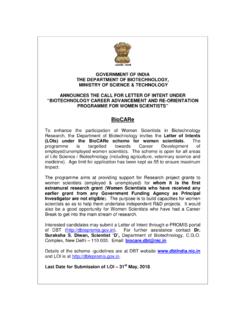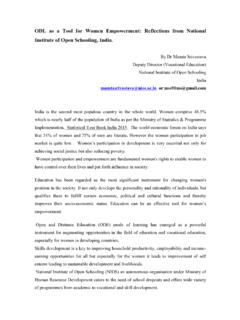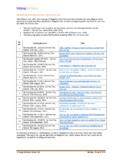Transcription of National Biotechnology Development Strategy
1 National BiotechnologyDevelopment Strategy2015-2020 Promoting bioscience research, education and entrepreneurshipDepartment of BiotechnologyMinistry of Science & TechnologyGovernment of IndiaNationalBiotechnologyDevelopmentStr ategy2015-2020 CONTENTSTHE I - KEY II SECTORAL Specialized training programs for New career options for Faculty improvement Attracting KNOWLEDGE facilities and Specialized centers in and around existing Strengthening core capacities in Proposed National research for gaining public Natural Product Technology Human Genome Vaccine Infectious Human Developmental and Disease Biology- Maternal & Child Chronic disease Stem cells and regenerative Biodesign Programme focused on implants, devices and Agriculture for food Crop Animal Products and Processes from Medicinal and Aromatic and utilization, management and biodiversity.
2 25 Environmental Biotechnology Development StrategyIndustrial Technologies for Clean Energy ..27 Bio systems and bioprocess Silk Genome Engineering Societal Promoting biotech in the North Eastern Region (NER)..30 Bioinformatics, computational and systems ENTREPRENEURSHIP - INTELLECTUAL , TECHNOLOGY TRANSFER, INCUBATORS, ENTREPRENEURSHIP, SME SUPPORT SYSTEMSS upport for business incubation infrastructure, ..31technology validation and scale-up infrastructureTechnology Management Professional Development and licensing for accelerated commercializationTechnology Bio Property AND Ensuring safety- Regulation of rDNA Encouraging safe Communicating International National ahead from Strategy - IThe Department of Biotechnology (DBT), government of india , announced the National Biotechnology Development Strategy in September 2007. Through the Strategy , Biotechnology was recognized as a sunrise sector that needed focussed attention.
3 The cornerstone of the Strategy was to focus on building coherence and connectivity between disciplines and bring together variegated skills across sectors to enhance guidelines for transgenic plants, recombinant vaccines and drugs, stem cell therapy have been evolved. A strong base of indigenous capabilities has been created. Many innovations and research applications for socio-economic Development have been supported in the areas of medical, agricultural, environmental and industrial Biotechnology . PPP models have been successfully implemented and a new section 25 company a Public Sector Undertaking, Biotechnology Industry Research Assistance Council (BIRAC), has been established to exclusively work on PPP programs in Biotechnology . Most of the new initiatives announced in the 2007 Strategy are in place. The implementation of Biotech Strategy 2007 has provided an insight into the enormous opportunities.
4 Thus, it was felt opportune to take a critical look at the Indian biotech sector as it will likely unfold over the next 5-6 years. The National Biotechnology Development Strategy -I 2015-2020 (hereinafter referred to as 'NBDS 2015-2020-II') is the direct result of formal and informal consultations over the past two years with over 300 stakeholders including scientists, educators, policy makers, leaders of industry and civil society, voluntary and non- government organizations, regulators and international experts. The consultations offered an opportunity to discuss and evaluate technological, societal and policy aspirations, critical success factors as well as barriers that will impede growth and put them in newer and broader perspective and action plan. The new Strategy would seamlessly build on the earlier Strategy to accelerate the pace of growth of Biotechnology sector at par with global requirements.
5 Boundaries between disciplines once considered distant are now beginning to blur and as a consequence of their convergence given birth to newer opportunities and challenges. Hence biotech education policies have to be reshaped to bring in breadth and depth as accelerated growth is propelled by both a highly skilled work force and talented leadership. Our universities need to be redesigned for evolving an ecosystem in which scientists, innovators and future entrepreneurs can be nurtured. University research output must show a quantum jump for us to achieve global competitiveness. Building a skilled workforce would accord top priority in our renewed up and sustainability are important for novel efforts and approaches to make institutional mechanisms of innovation empowering. Hence significant investment would be made for building the knowledge environment which would encompass niche research areas, 'the centres THE GENESIS2of excellence', innovation clusters, centralized R&D infrastructure and research tools - data centers, repositories.
6 Efforts would be taken to provide access to these research resources nationally. Life sciences research once perceived for understanding the creation and the nature, gradually evolved into technology oriented research aimed at improving the lives and living of millions. Of late, bioscience is being increasingly perceived as one of the potential enterprise activity capable of fulfilling societal needs through manufacturing and providing employment opportunities. Hence efforts would be directed in nurturing entrepreneurship and in accelerating technology for market absorption. Research in all areas of basic and interdisciplinary sciences using modern Biotechnology would be supported. Emphasis would be on generation of biotech products, processes and technologies to enhance efficiency, productivity, safety and cost effectiveness of agriculture, food and nutritional security; affordable health and wellness; environmental safety;clean energy and biofuel; and bio is a paradigm shift in the relation-ship between government , academia, industry and civil society.
7 This is critical for the new era of science-driven, society relevant innovation and entrepreneur-ship. DBT is committed to building newer instruments for connectivity. DBT would enter into strategic partnerships globally, nationally with other departments, ministries and private sector and more so with the society for achieving inclusive Biotechnology is a scientific revo-lution and creating the unseen, it is also our commitment in taking the public into confidence, in gaining public acceptance for biotech products, educating them, reaching out to them and providing a more participatory role for improving their understanding of our work. Regulation, standard setting and support of infrastructure for all this would be attended on priority. The consultations held have resulted not only in identifying ten guiding principles that will drive Strategy -II but also in detailing the instruments through which these principles will be implemented.
8 These are outlined in the key elements and sector-wise priorities. National Biotechnology Development Strategy3 Our renewed missionRealizing that Biotechnology has the potential to be a globally transformative intellectual enterprise of humankind, our renewed mission is to: Provide impetus to fulfilment of the potential for a new understanding of life processes and utilizing the knowledge and tools to the advantage of humanity; Launch a major, well directed effort backed by significant investment for generation of biotech products, processes and technologies to enhance efficiency, productivity, safety and cost effectiveness of agriculture, food and nutritional security; affordable health and wellness; environmental safety; clean energy and biofuel; and bio manufacturing. Empower, scientifically and technologically, india 's incomparable human resource; Create a strong infrastructure for research, Development and commercialization for a robust bioeconomy; Establish india as a world class bio manufacturing hub for developing and developed markets;Ten guiding principles that will drive the strategyConsultations with stakeholders have identified the following 10 guiding principles that shall drive the renewed mission through Strategy -II.
9 Building a skilled workforce and leadershipBiotechnology as a discipline is highly dynamic and rapidly evolving. Recognizing the importance of capacity and competence building, DBT prioritises the following for facilitating training, education and research aspirations of students, faculty and other biotech professionals. Specialized training programs for professionals - to facilitate technology competence and for updating professional skills required in the dynamic system. New career options for students - aimed at motivating young minds towards Biotechnology for a career and to make higher education, enterprise driven and interdisciplinary Faculty improvement Program - for continuous improvement, lateral growth and for recognition of the dedicated services rendered Attracting Skills - for imbibing the overseas talent (scientists and post docs) in our Development - 1 KEY ELEMENTS4 Revitalizing the knowledge environment at par with the growing bioeconomyCapacity for innovation and technology Development in Biotechnology rests largely on access to core facilities and instrumentation.
10 The Department of Biotechnology (DBT) is committed to building world-class facilities and its access across the country. In addition to providing support for core equipment in universities and research institutes, the following would be achieved. Networked resources/skills - Specialised centres in and around existing institutes as 'centres of excellence' or 'bioclusters' for physical amenities as well as the intangible benefits like specialized skill, competence and niche support. Strengthening core capacities in institutes- facilities for advanced research programs in existing institutions to empower them in transforming their expertise. National institutes for spearheading research and training in emerging areas of Biotechnology and which are highly relevant and specific for the Indian context. Data centers- DBT would evolve a National data policy for submission of publications arising out of public funded research to the National data center, which will consolidate it and make it publically available.










